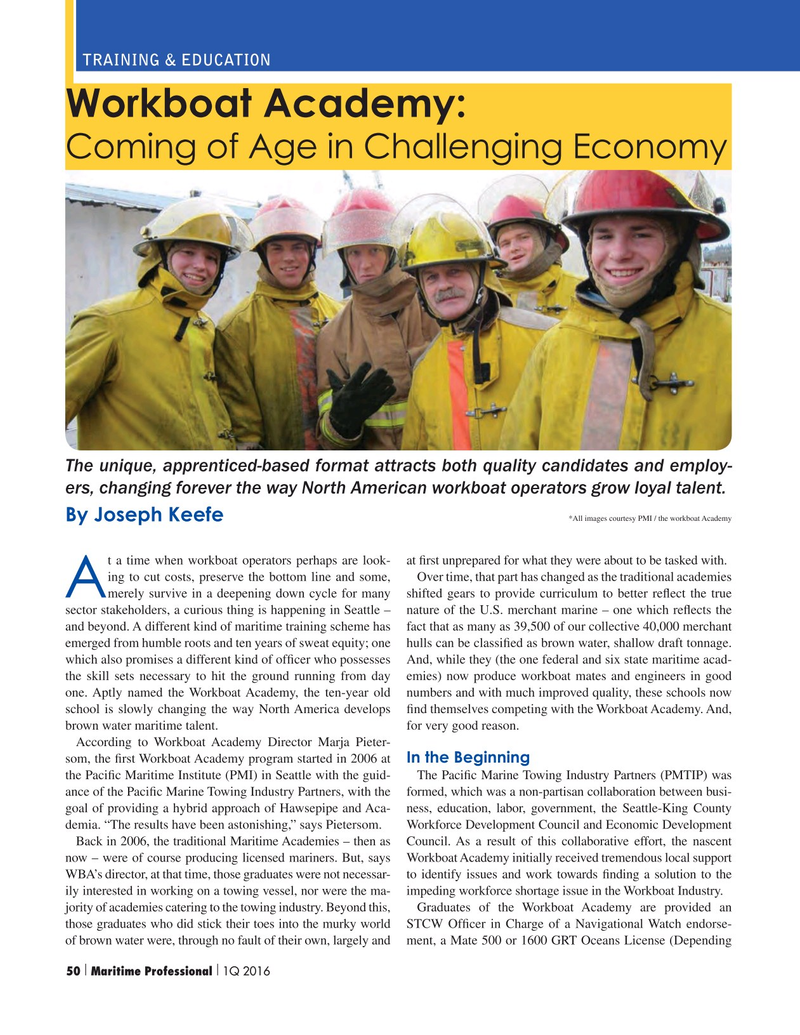
Page 50: of Maritime Logistics Professional Magazine (Q1 2016)
Maritime Training and Education
Read this page in Pdf, Flash or Html5 edition of Q1 2016 Maritime Logistics Professional Magazine
TRAINING & EDUCATION
Workboat Academy:
Coming of Age in Challenging Economy
The unique, apprenticed-based format attracts both quality candidates and employ- ers, changing forever the way North American workboat operators grow loyal talent.
*All images courtesy PMI / the workboat Academy
By Joseph Keefe t a time when workboat operators perhaps are look- at ? rst unprepared for what they were about to be tasked with.
ing to cut costs, preserve the bottom line and some, Over time, that part has changed as the traditional academies
Amerely survive in a deepening down cycle for many shifted gears to provide curriculum to better re? ect the true sector stakeholders, a curious thing is happening in Seattle – nature of the U.S. merchant marine – one which re? ects the and beyond. A different kind of maritime training scheme has fact that as many as 39,500 of our collective 40,000 merchant emerged from humble roots and ten years of sweat equity; one hulls can be classi? ed as brown water, shallow draft tonnage. which also promises a different kind of of? cer who possesses And, while they (the one federal and six state maritime acad- the skill sets necessary to hit the ground running from day emies) now produce workboat mates and engineers in good one. Aptly named the Workboat Academy, the ten-year old numbers and with much improved quality, these schools now school is slowly changing the way North America develops ? nd themselves competing with the Workboat Academy. And, brown water maritime talent. for very good reason.
According to Workboat Academy Director Marja Pieter-
In the Beginning som, the ? rst Workboat Academy program started in 2006 at the Paci? c Maritime Institute (PMI) in Seattle with the guid- The Paci? c Marine Towing Industry Partners (PMTIP) was ance of the Paci? c Marine Towing Industry Partners, with the formed, which was a non-partisan collaboration between busi- goal of providing a hybrid approach of Hawsepipe and Aca- ness, education, labor, government, the Seattle-King County demia. “The results have been astonishing,” says Pietersom. Workforce Development Council and Economic Development
Back in 2006, the traditional Maritime Academies – then as Council. As a result of this collaborative effort, the nascent now – were of course producing licensed mariners. But, says Workboat Academy initially received tremendous local support
WBA’s director, at that time, those graduates were not necessar- to identify issues and work towards ? nding a solution to the ily interested in working on a towing vessel, nor were the ma- impeding workforce shortage issue in the Workboat Industry.
jority of academies catering to the towing industry. Beyond this, Graduates of the Workboat Academy are provided an those graduates who did stick their toes into the murky world STCW Of? cer in Charge of a Navigational Watch endorse- of brown water were, through no fault of their own, largely and ment, a Mate 500 or 1600 GRT Oceans License (Depending 50 Maritime Professional 1Q 2016| | 50-63 Q1 MP2016.indd 50 2/29/2016 11:42:58 AM

 49
49

 51
51
